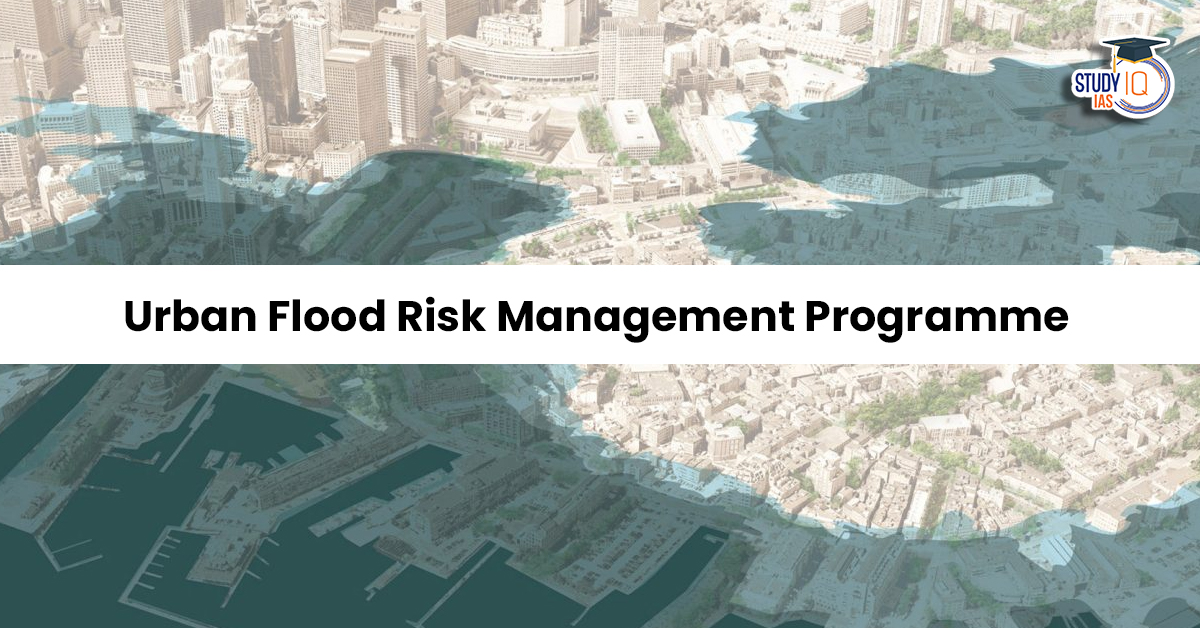Table of Contents
India’s cities are increasingly vulnerable to urban flooding due to rapid urbanization, poor drainage systems, and changing climate patterns. Frequent episodes of waterlogging, infrastructure damage, and livelihood disruptions in metropolitan areas highlight the urgent need for proactive flood management.
To address this challenge, the Government of India launched the Urban Flood Risk Management Programme (UFRMP) — a comprehensive initiative to strengthen flood resilience through modern infrastructure, scientific planning, and disaster preparedness.
Overview of the Urban Flood Risk Management Programme
The Urban Flood Risk Management Programme (UFRMP) is a flagship initiative under the national disaster mitigation framework. It aims to protect cities from recurring flood hazards by integrating engineering, ecological, and institutional approaches.
The programme combines structural measures such as improved drainage and flood barriers with non-structural measures like early warning systems, capacity-building, and urban planning reforms.
Objectives of UFRMP
The Urban Flood Risk Management Programme has been designed with the following objectives:
-
Mitigate Urban Flood Risk: Reduce the impact of floods in cities through preventive and adaptive measures.
-
Enhance Drainage and Water Management: Improve stormwater networks and restore natural drainage pathways.
-
Promote Nature-Based Solutions: Integrate wetlands, green corridors, and permeable surfaces into city planning.
-
Strengthen Early Warning Systems: Establish real-time monitoring and flood forecasting mechanisms.
-
Capacity Building and Public Awareness: Empower urban local bodies and communities to manage flood risks effectively.
-
Climate Resilience: Build sustainable, climate-adaptive urban environments for long-term protection.
Cities Covered Under UFRMP
The programme is being implemented in two phases to cover India’s most flood-prone and densely populated urban centres.
Phase 1:
Focused on seven major metropolitan cities – Chennai, Mumbai, Kolkata, Ahmedabad, Hyderabad, Bengaluru, and Pune.
Phase 2:
Extended to 11 additional cities including Bhopal, Bhubaneswar, Guwahati, Jaipur, Kanpur, Patna, Raipur, Thiruvananthapuram, Visakhapatnam, Indore, and Lucknow.
These cities were selected based on flood vulnerability, population density, and hydro-meteorological conditions.
Key Components of the Programme
1. Structural Measures
-
Construction and upgrading of stormwater drainage systems.
-
Flood protection walls and embankments.
-
Interlinking of lakes, ponds, and wetlands for water retention.
-
Installation of pumping stations and outfall channels.
-
Erosion control and soil stabilization along flood-prone corridors.
2. Non-Structural Measures
-
Development of digital flood forecasting and early warning systems.
-
Real-time data monitoring and information-sharing networks.
-
Integration of flood zoning and risk maps into urban master plans.
-
Community-based flood preparedness and evacuation plans.
-
Regular capacity-building programs for local government officials.
3. Nature-Based Solutions
-
Restoration of wetlands and urban ponds.
-
Creation of green buffer zones, bioswales, and rain gardens.
-
Use of permeable pavements to improve groundwater recharge.
-
Integration of ecological infrastructure into flood control systems.
Funding and Implementation
The Urban Flood Risk Management Programme is implemented under the National Disaster Mitigation Fund (NDMF) with a cost-sharing model between the central and state governments.
-
Central Government Share: 90%
-
State Government Share: 10%
The projects are executed through a collaboration of state disaster management authorities, urban development departments, and municipal corporations. Each city receives funding for specific interventions based on its flood risk profile and preparedness plan.
Special Focus: Flood Mitigation in Guwahati
Guwahati, one of the most flood-prone cities in Northeast India, has been given a dedicated project under UFRMP with a total outlay of ₹200 crore. The plan includes:
-
Interlinking of water bodies.
-
Stormwater management systems.
-
Construction of flood protection walls.
-
Soil stabilization using nature-based methods.
-
Deployment of flood early warning systems.
This project will serve as a model for other Indian cities facing similar geographical and climatic challenges.Benefits of the UFRMP
-
Improved Urban Infrastructure: Cities will have stronger drainage systems capable of handling heavy rainfall.
-
Reduced Economic Losses: Timely flood management will minimize property damage and business disruption.
-
Enhanced Community Safety: Early warning systems and better evacuation planning will reduce casualties.
-
Environmental Sustainability: Restoration of wetlands and use of green infrastructure will improve ecological balance.
-
Boost to Urban Livability: Cleaner water bodies, reduced stagnation, and better sanitation will enhance city living standards.
Challenges in Implementation
Despite its significance, the UFRMP faces several challenges:
-
Encroachment on natural drains and floodplains.
-
Coordination gaps between multiple urban agencies.
-
Maintenance issues with drainage systems after construction.
-
Lack of advanced flood modelling and forecasting tools.
-
Inadequate public awareness and local participation.
Addressing these challenges through strong governance and technology adoption is essential for the long-term success of the programme.
Future Outlook
The Urban Flood Risk Management Programme represents a critical shift towards climate-resilient urban planning. It emphasizes the need to combine engineering solutions with ecological restoration to make cities safer, greener, and more sustainable.
With India’s urban population expected to cross 600 million by 2035, integrated flood management is not just a necessity but a prerequisite for resilient development. By effectively implementing UFRMP, India can build cities that withstand extreme weather events while preserving their natural ecosystems.
Conclusion
The Urban Flood Risk Management Programme (UFRMP) is a transformative initiative that addresses one of the most pressing challenges of modern urban India — urban flooding. Through innovation, cooperation, and ecological planning, it aims to transform vulnerable urban spaces into resilient and sustainable ecosystems.
By focusing on prevention rather than reaction, the programme represents a milestone in India’s journey towards building disaster-resilient, climate-smart cities.


 Rare Hawfinch Sighting in Corbett Nation...
Rare Hawfinch Sighting in Corbett Nation...
 Bnei Menashe Community : The Lost Tribe ...
Bnei Menashe Community : The Lost Tribe ...
 Animal Husbandry Statistics 2025: Global...
Animal Husbandry Statistics 2025: Global...

























